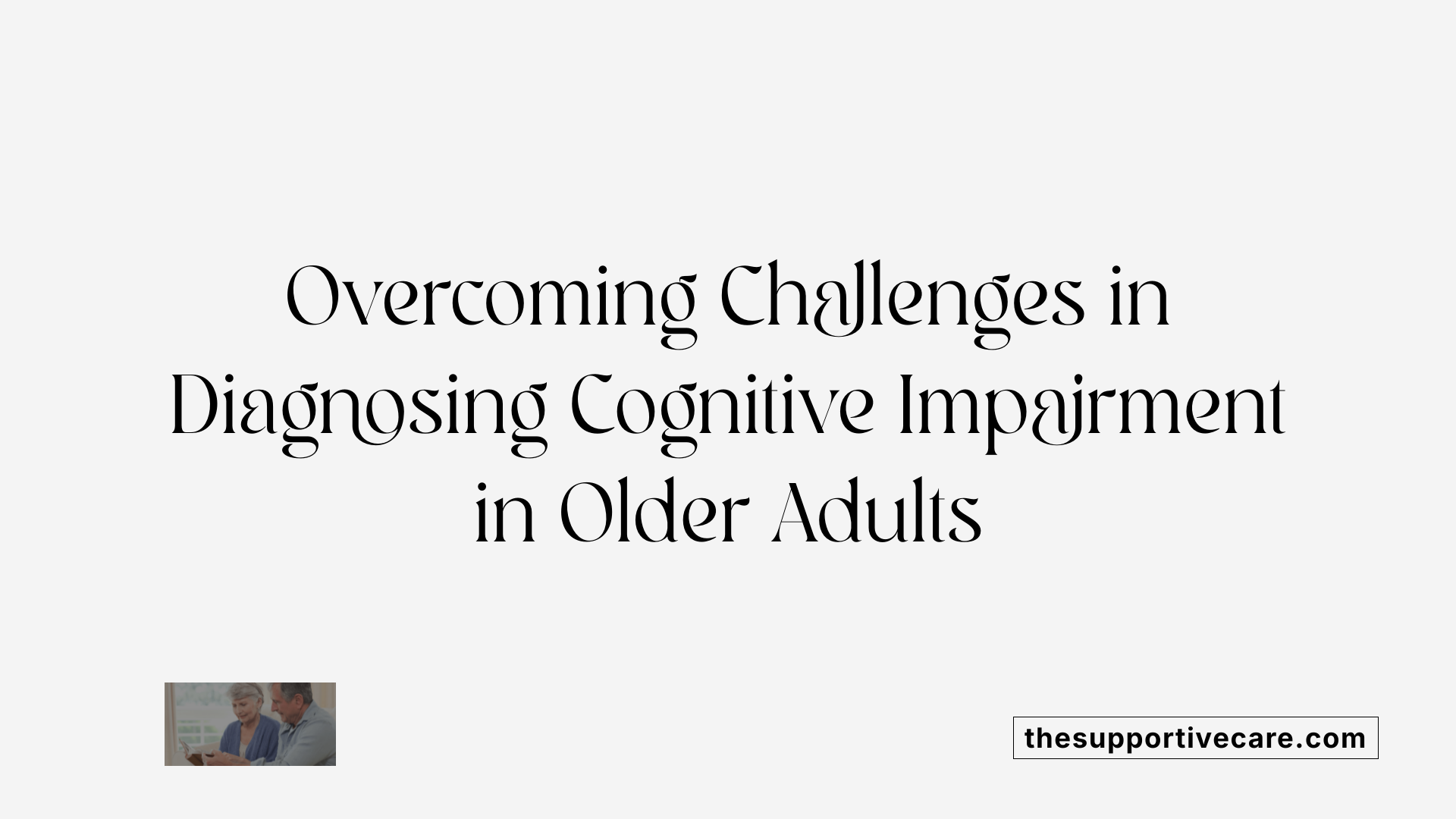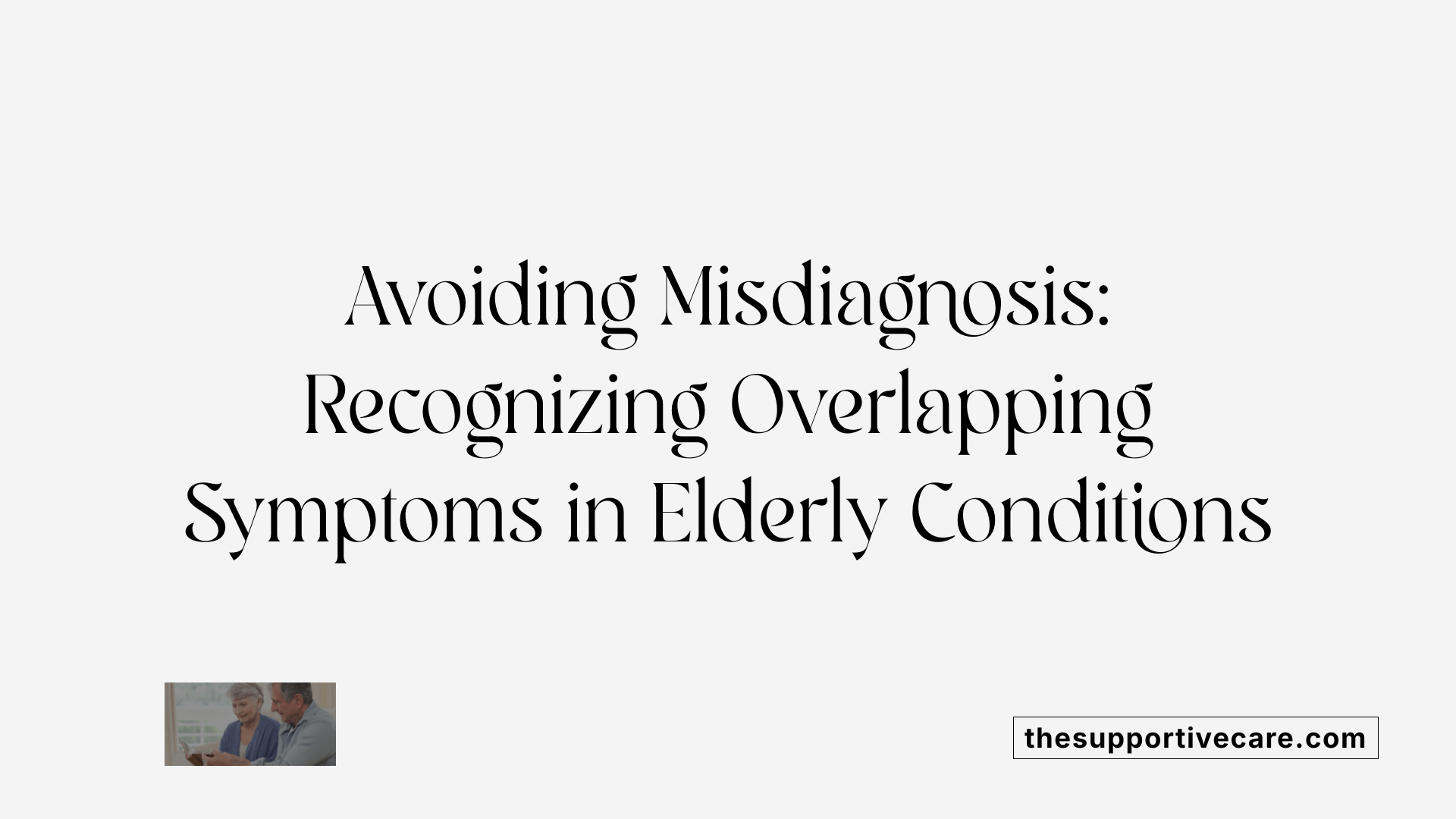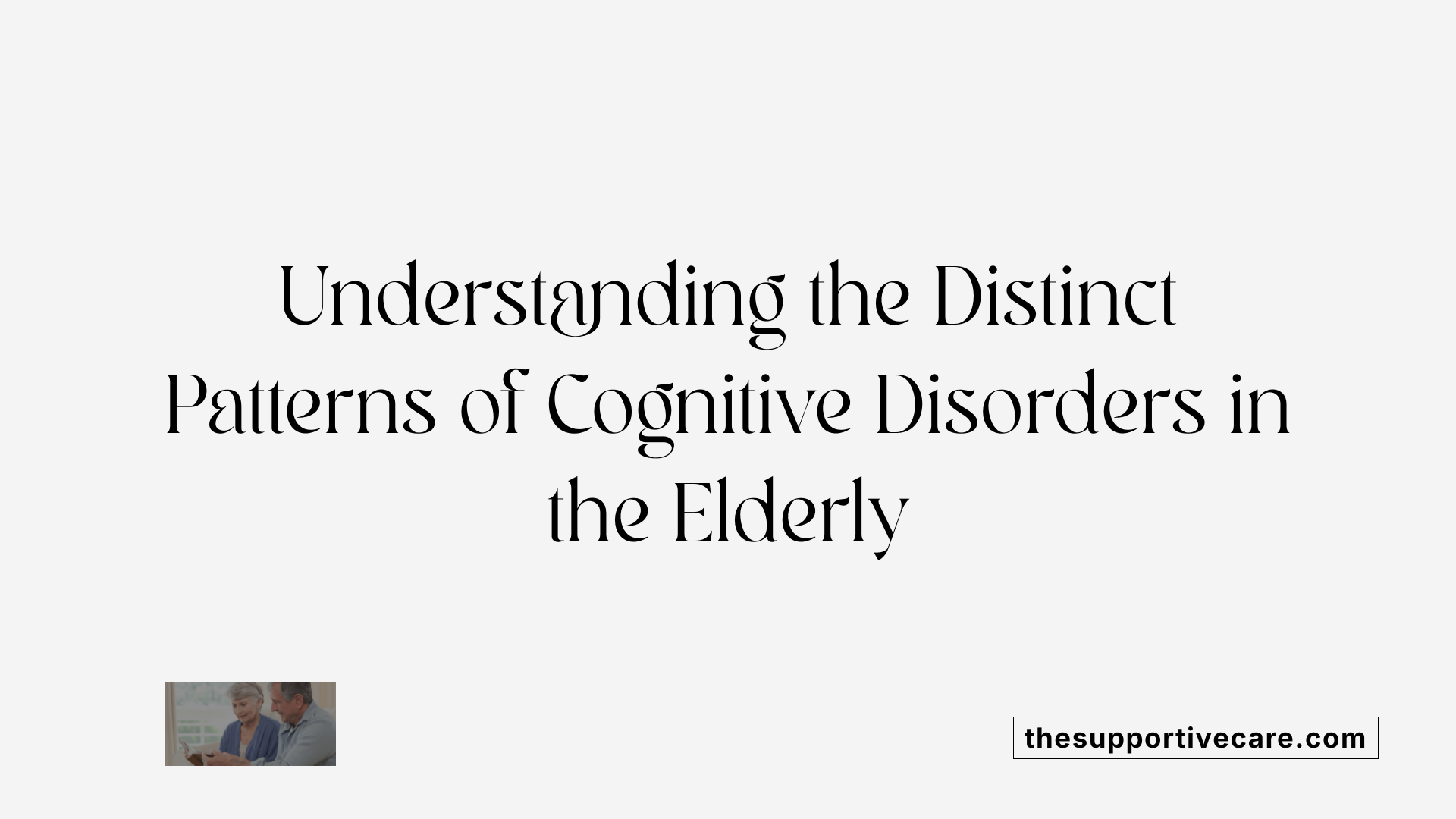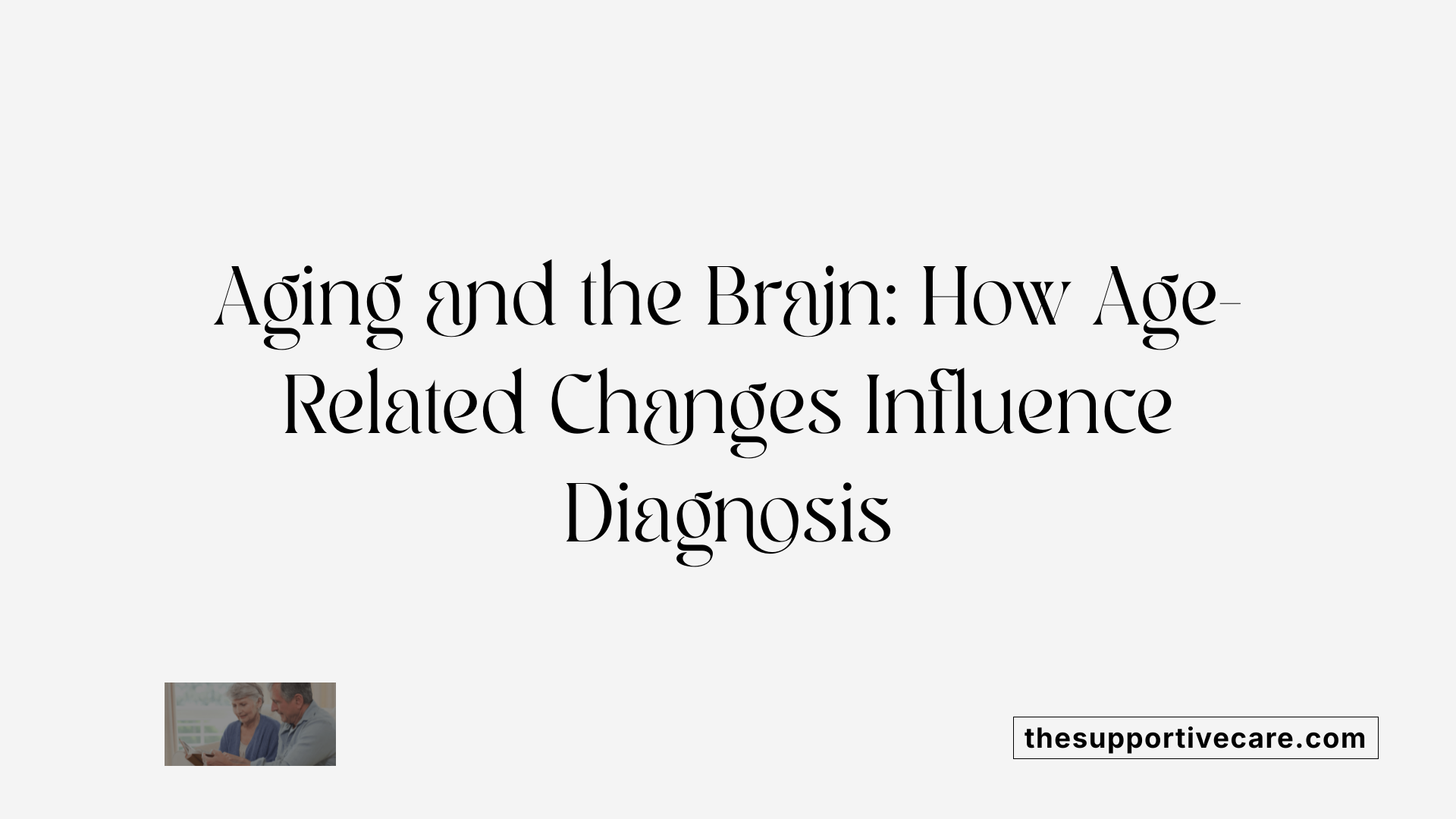Understanding the Complexity of Elder Care Mental Health
As the elderly population grows, healthcare providers and caregivers face increasing challenges in accurately diagnosing and managing mental health conditions such as depression, dementia, and delirium. These disorders often present overlapping symptoms, making differential diagnosis essential for effective treatment. This article explores key strategies, clinical features, and assessment tools to distinguish between cognitive impairment and depression, ensuring optimal care in elder populations.
Recognizing Symptoms of Depression in the Elderly
What are the key symptoms to recognize depression in older adults?
Depression in elderly patients often presents with a variety of emotional, cognitive, and physical symptoms. Recognizing these signs early is critical for timely intervention.
One of the most prominent features is a persistent low or anxious mood, often described as feelings of sadness, emptiness, or anxiety that last for several weeks or longer. Elderly individuals may not always express traditional feelings of sadness; instead, they might report feelings of hopelessness, worthlessness, or guilt that linger.
In addition to mood disturbances, irritability, agitation, or restlessness are common. Some seniors may find it hard to sit still or may appear more agitated than usual. Loss of interest or pleasure in activities that they once enjoyed, such as hobbies, social interactions, or daily routines, is another hallmark.
Physical symptoms are frequently observed, including fatigue, sleep disturbances (either insomnia or hypersomnia), appetite changes, and slowed movements or speech. These physical signs can often be mistaken for normal aging or other medical conditions, which underscores the importance of careful assessment.
Cognitive and behavioral changes also serve as indicators. Difficulties concentrating, memory problems, and persistent thoughts about death or suicide may be present. It is vital to understand that depression does not always manifest with overt sadness in the elderly. Sometimes, physical complaints, withdrawal, or somatic symptoms may be the primary presentation.
Recognizing these symptoms requires sensitivity and an awareness that depression in older adults can sometimes be masked or mistaken for age-related decline or dementia. Early screening tools like the Geriatric Depression Scale (GDS) or Beck Depression Inventory (BDI) can assist healthcare professionals in identifying at-risk individuals.
In summary, key signs include persistent mood disturbances, feelings of despair or worthlessness, irritability, loss of interest, physical complaints such as fatigue or sleep issues, and thoughts of death. Addressing these symptoms promptly can significantly improve quality of life and reduce the risk of associated health complications.
Differentiating Depression and Dementia: Key Clinical Features
How can clinicians differentiate between depression and dementia in elderly patients?
Distinguishing between depression and dementia in older adults is crucial for implementing proper treatment strategies. Clinicians rely on several clinical features and assessment tools to make this differentiation.
One of the first indicators is patient awareness. Elderly individuals with depression often remain aware of their cognitive lapses and may report feelings of sadness, hopelessness, or guilt. They tend to recognize their memory issues and emotional distress. In contrast, those with dementia frequently lack insight into their cognitive decline, often denying or being unaware of their memory problems or disorientation.
The pattern and onset of symptoms also differ. Depression usually presents with a recent, sometimes abrupt, onset of mood disturbances and cognitive complaints, which can improve with treatment. Memory lapses in depression are often variable and may not progressively worsen; patients typically recognize these lapses. Conversely, dementia develops gradually over months to years, with relentless progression of memory deficits and decline in other cognitive functions.
Mood and emotional expression provide additional clues. Depression is characterized by persistent low mood, anhedonia, and feelings of despair. Emotional symptoms are stable or fluctuate mildly. In dementia, mood episodes may include apathy, irritability, or agitation, but these are often secondary to cognitive decline.
Language and communication also differ between the two. In depression, language skills usually remain intact; speech is normal, and individuals can engage in conversations. However, in dementia, especially in the later stages, patients may experience word-finding difficulties, reduced speech, and impaired ability to communicate effectively.
Assessment of Activities of Daily Living (ADLs) and Instrumental Activities of Daily Living (IADLs) can reveal functional differences. Depression often causes temporary withdrawal or decreased motivation, but many patients can still perform basic tasks with support. Dementia leads to progressive difficulty with routine activities, such as managing finances, cooking, or grooming.
Clinicians also incorporate neuropsychological testing and comprehensive clinical evaluations. Tests like the Mini-Mental State Examination (MMSE) help quantify cognitive deficits. Memory impairment that is persistent and involves new learning problems suggests dementia, while fluctuating or task-specific lapses may point toward depression.
In summary, differentiating depression from dementia involves a detailed assessment of symptom onset, awareness, mood stability, language skills, functional status, and test results. Combining these factors provides a clearer clinical picture, ensuring accurate diagnosis and optimal treatment.
| Feature | Depression | Dementia | Additional Details |
|---|---|---|---|
| Onset | Usually weeks to months | Gradual over months to years | Pattern helps differentiate early signs |
| Patient awareness | Generally aware of deficits | Often lack awareness or deny issues | Insight varies, aiding assessment |
| Mood presentation | Persistent sadness, hopelessness | Apathy, irritability, mood swings | Mood assessment crucial |
| Memory deficits | Variable, with insight | Progressive, interfere with daily life | Pattern of memory loss distinguishes |
| Language abilities | Usually preserved | Difficulties in naming, speech | Language decline indicates progression |
| Daily activities | Often preserved initially | Progressive impairment | Functional status reveals extent |
| Neuropsychological tests | Variable, often inconsistent | Consistent deficits, especially memory | Objective testing supports diagnosis |
Understanding these differences allows healthcare providers to tailor interventions, offer appropriate support, and improve outcomes for elderly patients affected by these conditions.
Common Challenges in Diagnosing Cognitive Impairment in Elders

What are the common challenges in diagnosing cognitive impairment in older adults?
Diagnosing cognitive impairment among the elderly presents several hurdles, primarily because conditions like delirium, depression, and dementia often exhibit overlapping symptoms. These three disorders — sometimes referred to collectively as the 'three D's' — are prevalent in geriatric populations and notoriously difficult to differentiate.
One major challenge is the similarity in clinical presentation. Memory problems, disorientation, and behavioral changes are common features shared across delirium, depression, and dementia. For example, depression can cause pseudodementia, which closely mimics true dementia but is reversible with appropriate treatment.
Adding to the complexity is the variability in how these conditions manifest. Delirium typically presents suddenly over hours to days, with fluctuating alertness and attention. Conversely, dementia develops insidiously over months or years, with slow progression. Depression may develop gradually or suddenly, often triggered by psychosocial stressors or health decline.
Screening tools such as the Mini-Mental State Examination (MMSE) and others have limitations, particularly in early or mild cases. They may lack sensitivity to detect subtle changes or differentiate between the conditions when symptoms are mild.
Furthermore, many elderly individuals have multiple health issues—comorbidities like cardiovascular disease, diabetes, or neurological conditions—that can influence cognitive status. Polypharmacy, or the use of multiple medications, often results in side effects such as confusion or sedation, complicating diagnosis.
In addition, early signs of these disorders may be subtle or dismissed as normal aging. For instance, slight forgetfulness or mood fluctuations are often considered typical of aging, which can delay recognition and diagnosis.
A comprehensive assessment is essential. This includes detailed medical history, physical and neurological examinations, neuropsychological testing, and collateral information from family or caregivers. Always considering the broader health context helps in distinguishing among these overlapping conditions.
In summary, the challenges in diagnosing cognitive impairment in the elderly are multifaceted, stemming from symptom overlap, biological variability, diagnostic tool limitations, and the influence of comorbidities. Overcoming these requires a nuanced, multi-dimensional approach to assessment and diagnosis.
Why Misdiagnosis Occurs: Overlapping Features and Symptom Similarities

Why can depression, delirium, and age-related memory impairment be mistaken for dementia?
Depression, delirium, and age-related memory impairment often present with symptoms similar to dementia, such as memory loss, confusion, and behavioral changes. These overlapping features can create challenges in distinguishing between them during clinical assessment.
All three conditions may cause difficulties with concentration, disorientation, and changes in mood. For instance, depression may lead to forgetfulness, fatigue, and apathy, which sometimes are mistaken for early dementia. Similarly, delirium can cause sudden confusion and fluctuating alertness that mimic cognitive decline.
The differences, although subtle, are important for accurate diagnosis. Depression often has a rapid onset, with symptoms that can improve with treatment when identified early. Delirium is characterized by a sudden, acute presentation that fluctuates during the day and is often reversible once the underlying medical cause—like infection or medication effect—is addressed.
Conversely, dementia develops insidiously and progresses gradually over months or years, with a decline in multiple cognitive domains such as memory, language, and executive functions. Patients with dementia are frequently unaware of their deficits, contrasting with depressed individuals who are typically aware of their mood and memory problems.
Understanding the course and associated features of each condition is essential. Proper diagnosis impacts treatment decisions—reversible conditions like depression and delirium can often be managed effectively, whereas dementia currently has no cure and requires long-term care planning.
Variability in onset and progression
Monitoring how symptoms start and change over time assists clinicians in differentiation. Depression tends to begin suddenly, often linked to stressful events or health crises, while delirium occurs within hours to days in hospital or medical settings, and dementia manifests with a slow, progressive decline.
The progression in dementia is typically insidious, with a gradual worsening evident over years. Recognizing this timeline helps to distinguish between these disorders.
Assessment limitations and diagnostic pitfalls
Standard cognitive screening tools like the Mini-Mental State Examination (MMSE) can aid in evaluation but have limitations. For example, they may not detect early or mild dementia and can be influenced by educational and cultural factors. Additionally, symptoms like apathy or agitation may be misinterpreted if not evaluated within the broader clinical context.
False positives can occur when symptoms of depression are mistaken for early dementia, leading to unnecessary referrals or interventions. Similarly, psychotropic medications or acute illnesses can confound assessment.
Neuroimaging and biomarker testing are valuable adjuncts, especially when clinical findings are ambiguous. Incorporating collateral history from family and close contacts also enhances diagnostic accuracy.
The importance of considering medical causes
Since delirium is often caused by underlying medical issues—such as infections, electrolyte imbalances, or medication effects—treating the root cause can resolve the cognitive disturbance.
In older adults, comorbid conditions are common, and they may co-occur with depression or dementia, further complicating diagnosis. A comprehensive medical workup, including blood tests, urine analysis, and review of medication history, is necessary.
Manifestations like confusion, memory issues, mood changes
In clinical practice, clinicians observe that symptoms like confusion, impaired memory, and mood alterations can be present across different conditions. For example, confusion out of context and fluctuating alertness suggest delirium, while persistent memory deficits and behavioral changes point towards dementia.
Mood symptoms—such as persistent sadness, irritability, or apathy—are typical of depression but can also be seen in dementia, especially in later stages. Recognizing their patterns and context helps differentiate these diagnoses.
In conclusion, overlapping features among depression, delirium, and dementia pose diagnostic challenges. Careful assessment of onset, course, neuropsychological testing, medical evaluation, and collateral information are essential strategies to avoid misdiagnosis and ensure appropriate treatment.
Differences in Onset, Course, and Features of Cognitive Disorders

What are the key differences between depression, dementia, and delirium?
Depression, dementia, and delirium are three common neuropsychiatric conditions in older adults, each with distinct features concerning their onset, progression, and clinical presentation.
Time course of depression, dementia, delirium
Depression in the elderly usually develops gradually over weeks to months, often characterized by persistent sadness, anhedonia, and somatic complaints. It may also present with cognitive symptoms that can mimic dementia, known as pseudodementia.
In contrast, dementia typically has a slow, insidious onset, evolving over months or years. Patients progressively experience memory loss, language difficulties, and impaired reasoning, with a gradual decline in daily functioning.
Delirium, however, manifests rapidly, within hours to days. It is an acute disturbance of consciousness and attention that fluctuates during the day, often worsening at night.
Symptoms fluctuation and stability
A hallmark of delirium is its fluctuating symptoms—patients may appear alert at times and drowsy or confused at others. Mood in delirium can swing wildly, with visual hallucinations or illusions common.
Depression tends to be more stable, with sustained low mood, although some symptoms like sleep disturbance and psychomotor retardation may fluctuate slightly.
Dementia shows a relatively steady progression, with cognitive function steadily declining without sudden changes, though early stages may be subtle and frequently unnoticed.
Pattern of progression
The course of each condition varies profoundly:
- Depression often responds well to treatment, and mood improvement can lead to cognitive improvement if pseudodementia is present.
- Dementia progresses gradually, with no current cure, but early diagnosis helps in managing symptoms and planning care.
- Delirium is usually reversible once the underlying medical cause, such as infection or medication effect, is treated.
Assessment of awareness and insight
Patients with depression typically recognize their mood symptoms and can provide detailed insight into their condition.
Dementia patients often lack awareness of their cognitive deficits, which can delay seeking help and complicate diagnosis.
In delirium, awareness is markedly impaired; patients are often disoriented and unable to recognize their environment or deficits.
Key features for differentiation
Differentiating these conditions involves noting specific features:
- Onset: Rapid (hours to days) in delirium; slow (weeks to months) in depression; very slow (months to years) in dementia.
- Symptom fluctuation: Present in delirium, less so in depression, and minimal in early dementia.
- Progression: Reversible in delirium; gradually worsening in dementia; fluctuating or resolved with treatment in depression.
- Mood patterns: Persistent low mood in depression; fluctuating emotional states in delirium; often apathy or irritability in dementia.
- Insight: Preserved in depression, impaired in dementia, and markedly impaired in delirium.
Understanding these differences is vital for clinicians to ensure accurate diagnosis and appropriate management of elderly patients exhibiting cognitive and behavioral symptoms.
Summary table of features
| Feature | Depression | Dementia | Delirium |
|---|---|---|---|
| Onset | Weeks to months | Months to years | Hours to days |
| Symptom fluctuation | Usually stable | Usually stable | Fluctuates during the day |
| Course | Usually reversible | Progressive | Reversible with treatment |
| Awareness of deficits | Typically aware | Often unaware | Usually unaware |
| Mood features | Persistent sadness, anhedonia | Apathy, irritability | Mood swings, agitation |
| Key neuropsychological signs | Memory complaints, slow thinking | Memory loss, language deficits | Disorganized thinking, hallucinations |
Accurately distinguishing between these conditions relies on careful assessment of their timing, symptoms, and fluctuations, supported by cognitive testing and clinical judgment.
Search query: Differences in cognitive disorder onset elderly
Reversibility of Cognitive Decline Due to Depression
Can cognitive decline caused by depression be reversed?
Depression-related cognitive impairment, often termed pseudodementia, is notably reversible with proper treatment. Unlike neurodegenerative dementia, which typically worsens over time, depression-induced cognitive deficits tend to improve significantly when the underlying mood disorder is effectively managed.
Treatment approaches include pharmacotherapy, primarily with antidepressants such as selective serotonin reuptake inhibitors (SSRIs), serotonin-norepinephrine reuptake inhibitors (SNRIs), or tricyclic antidepressants (TCAs). These medications can alleviate depressive symptoms, which often leads to concurrent improvements in cognitive functions like attention, memory, and executive functioning. Psychotherapeutic interventions, especially cognitive-behavioral therapy (CBT), are also beneficial for addressing both mood and cognitive symptoms.
Recent studies highlight that certain antidepressants, such as vortioxetine, possess specific procognitive effects. These agents can improve cognitive domains independently of their mood-stabilizing properties, suggesting a direct benefit on neural circuits involved in cognition.
However, not all antidepressants have demonstrated equivalent cognitive benefits. The variability underscores the importance of personalized treatment plans and possibly combining medication with cognitive training or rehabilitation techniques.
While many patients experience symptom remission, some cognitive deficits may persist even after mood improvement. These residual problems can include issues with processing speed, executive functions, or memory—highlighting the need for ongoing assessment and possibly adjunctive cognitive therapies.
Differentiating reversible pseudodementia from actual neurodegenerative conditions is crucial for appropriate management. Neurodegenerative diseases like Alzheimer’s typically involve a steady progression and are less responsive to psychiatric treatments. Conversely, depression-related cognitive issues often resolve or markedly diminish with effective depression treatment.
Signs of recovery soon after initiating therapy include improved mood, increased motivation, enhanced concentration, better memory performance, and a reduction in other cognitive complaints. Continual follow-up and neuropsychological assessments are essential to monitor progress.
In summary, cognitive decline associated with depression can often be reversed, especially if diagnosed early and treated adequately. Recognizing and treating depression promptly is pivotal to preventing misdiagnosis and ensuring better outcomes for cognitive health in the elderly.
Assessment Tools and Biological Markers for Accurate Diagnosis
How can clinicians distinguish between depression, dementia, and delirium?
Clinicians employ a combination of clinical observation, cognitive assessment scales, neuropsychological testing, neuroimaging, and biomarker analysis to differentiate these conditions effectively. Understanding their onset, progression, and characteristic features is essential.
Cognitive Assessment Scales such as the Mini-Mental State Examination (MMSE), Brief Interview for Mental Status (BIMS), and Montreal Cognitive Assessment (MoCA) are standard tools. These scales evaluate memory, attention, language, and executive functions. For instance, in dementia, scores typically decline gradually, while in depression, cognitive deficits may be more variable and sometimes improve with mood treatment. Electroencephalograms (EEG) can support diagnosis by showing characteristic patterns; for example, generalized slowing in dementia or specific patterns in delirium.
Neuropsychological Testing Profiles reveal cognitive strengths and weaknesses across domains. Patients with depression often show impairments in attention and executive functioning but may retain relatively intact memory. Conversely, dementia often presents with prominent memory impairments and language difficulties. In depression, deficits may persist during remission, whereas in dementia, they tend to worsen over time.
Role of Neuroimaging such as Magnetic Resonance Imaging (MRI) and Computed Tomography (CT) scans help identify structural brain changes. For instance, medial temporal atrophy and hippocampal volume loss suggest Alzheimer’s disease, while other patterns may support different diagnoses. Biomarkers such as amyloid-beta (Aβ42) and tau proteins in cerebrospinal fluid (CSF) provide molecular evidence. Elevated tau and decreased Aβ42 levels are associated with AD, aiding differentiation from depression.
More Advanced Imaging and Biomarkers include positron emission tomography (PET) scans that detect amyloid plaques or neurofibrillary tangles, specific to Alzheimer’s pathology.
Differentiating features from biomarkers and imaging
| Feature | Depression | Dementia | Delirium |
|---|---|---|---|
| Symptom Onset | Weeks to months | Months to years | Hours to days |
| Course | Often fluctuates, improves with treatment | Progressive, steady decline | Fluctuates throughout the day |
| Cognitive Profile | Memory and attention may be impaired, but often reversible | Memory, language, executive function decline | Disorganized thinking, hallucinations |
| Structural Changes | Usually no significant atrophy | Medial temporal atrophy, hippocampal volume loss | Usually no structural changes |
| Biomarkers | No Alzheimer’s-specific biomarkers | Elevated tau, decreased Aβ42 | Not typically used |
| Imaging | No distinctive pattern | Characteristic atrophy patterns on MRI or CT | No specific imaging findings |
Understanding these tools and markers enables healthcare providers to make accurate diagnoses, which is crucial for implementing appropriate treatment strategies and improving elderly patient outcomes.
The Impact of Aging on Brain Changes and Their Role in Diagnosis

How does aging affect brain function and influence the presentation of mental disorders?
Aging brings about several structural and functional changes in the brain, which play a significant role in how mental disorders manifest in older adults. As individuals age, the brain typically experiences a reduction in overall weight, neuronal loss, and changes in neurotransmitter systems. These alterations can affect cognition, mood, and behavior.
Structurally, common findings include cortical atrophy, especially in the frontal lobes, hippocampal volume reduction, and increased white matter hyperintensities visible on neuroimaging. These changes are often associated with decreased processing speed, impaired executive functioning, and memory difficulties, which can resemble or obscure the symptoms of dementia.
Neurobiological factors, such as alterations in serotonin, dopamine, and noradrenaline pathways, also influence mood regulation and cognitive resilience, thereby affecting the presentation of depression and other mood disorders.
Furthermore, cerebrovascular changes like small vessel disease, arteriosclerosis, and microinfarcts are prevalent in the elderly. These vascular alterations can lead to vascular cognitive impairment and contribute to fluctuating cognitive and emotional symptoms.
Brain atrophy and neuronal loss
Brain atrophy involves the shrinkage of brain tissue, notably in regions responsible for memory and decision-making, such as the hippocampus and prefrontal cortex. Neuronal loss exceeds what is observed in younger adults and is linked to declines in cognitive function.
While some degree of neuronal loss is a normal component of aging, excessive or accelerated loss is associated with neurodegenerative diseases like Alzheimer’s disease.
Neurobiological factors influencing presentation
Changes in neurotransmitters influence symptom presentation. For example, decreases in serotonergic activity may lead to depression, while dopaminergic deficits can affect motivation and executive functions. Such neurochemical alterations can sometimes mimic psychiatric conditions, necessitating careful assessment.
Cerebrovascular changes and vascular pathology
Vascular pathology, including white matter lesions and microbleeds, are common in older individuals. These can manifest as stepwise cognitive decline, gait disturbances, or mood symptoms, often complicating diagnosis.
Vascular contributions to cognitive decline can coexist with neurodegenerative processes, creating a complex clinical picture often termed mixed dementia.
Implications for clinical diagnosis
Understanding these age-related brain changes is vital for clinicians assessing mental health in the elderly. For instance, mild cognitive decline might be within the normal aging spectrum or indicative of early pathology.
Diagnostic tools like neuropsychological testing should be interpreted considering age-related norms, and neuroimaging can assist in differentiating normal atrophy from disease-specific patterns.
Assessment strategies must also account for neurobiological influences when diagnosing depression, delirium, or dementia, ensuring that treatment plans are tailored appropriately.
Through this nuanced understanding of the aging brain, healthcare providers can improve diagnostic accuracy, early detection, and management of mental disorders in older patients.
Strategies for Effective Elder Mental Health Management

How can clinicians distinguish between depression, dementia, and delirium?
Distinguishing among depression, dementia, and delirium requires understanding their distinctive features, onset, and course. Clinicians analyze the timeline and characteristics of symptoms to make an accurate diagnosis.
Delirium is an acute condition that develops rapidly over hours or days. It presents with fluctuating levels of consciousness, attention deficits, disorganized thinking, and perceptual disturbances such as hallucinations or illusions. Often triggered by medical issues like infections, electrolyte imbalances, or medication effects, delirium is reversible once the underlying cause is treated.
Dementia, on the other hand, tends to progress gradually over months or years. It is characterized by steady cognitive decline, including memory impairment, language difficulties, and challenges with abstract thinking. Patients with dementia often do not recognize their cognitive deficits, and the disease is generally not reversible. The subtle and slow onset can lead to it being mistaken for normal aging.
Depression presents with persistent low mood lasting at least two weeks, often coupled with symptoms like withdrawal from activities, apathy, feelings of hopelessness, and physical complaints such as fatigue. Unlike delirium or dementia, depression may show mood improvements with appropriate treatment.
Additional differentiators include the fluctuation of symptoms in delirium, the insidious and progressive nature of dementia, and the mood-related signs associated with depression. Mood in depression is typically low or apathetic, whereas mood in delirium and dementia may fluctuate.
Recognizing these differences is critical for targeted intervention. Tools such as neuropsychological tests and assessments of daily functioning aid clinicians in this differentiation, ensuring proper care tailored to each condition.
Multimodal assessment approaches
Assessing elderly patients' mental health involves a comprehensive approach. This includes clinical interviews, neuropsychological testing like the Mini-Mental State Examination (MMSE), and evaluation of Activities of Daily Living (ADLs) and Instrumental Activities of Daily Living (IADLs). Changes from baseline in cognitive functioning and daily capabilities can indicate emerging or worsening conditions.
Integration of neuropsychological tests and biomarkers
To improve diagnostic accuracy, clinicians increasingly incorporate neuropsychological assessments with biomarkers. Imaging techniques such as MRI detect brain atrophy patterns typical of Alzheimer’s disease, while cerebrospinal fluid (CSF) analysis for amyloid-beta (Aβ42) and tau proteins helps distinguish dementia from depression-related cognitive deficits. Elevated hippocampal size reduction and medial temporal atrophy are also linked with Alzheimer’s.
Early detection and intervention protocols
Prompt detection of cognitive and mood symptoms is essential for effective management. Protocols include screening tools like the Geriatric Depression Scale (GDS) and Memory Impairment Screen. Early recognition facilitates timely treatment, which can slow progression, improve quality of life, and prevent complications.
Patient and caregiver education
Educating patients and their caregivers about the signs and differences among depression, dementia, and delirium is vital. Awareness helps in early reporting of symptoms, adherence to treatment plans, and reducing stigma.
Nonpharmacological interventions such as social support and mental stimulation
Supportive approaches include engaging in social activities, mental exercises, physical activity, and routine establishment. These interventions support cognitive health, combat social isolation, and enhance mood.
Long-term management and monitoring strategies
Ongoing follow-up with periodic assessments is essential. Adjusting medications, providing psychotherapy, and involving multidisciplinary teams minimize relapse, monitor disease progression, and optimize overall well-being.
| Aspect | Depression | Dementia | Delirium |
|---|---|---|---|
| Onset | Weeks to months | Months to years | Hours to days |
| Course | Persistent, may fluctuate | Gradual, irreversible | Fluctuating, reversible |
| Mood | Usually low/apathetic | Possible mood changes | Emotional fluctuations |
| Motor Activity | Usually normal; may be agitation or withdrawal | Often normal; may have wandering or inaction | Hyperactivity or hypoactivity |
| Awareness | Usually aware | Often unaware | Usually aware but confused |
| Cognitive Features | Intact thinking, feelings of helplessness | Disorganized or slow thinking | Disoriented, fragmented thinking |
| Neurobiology | Serotonin, dopamine, noradrenaline deficits | Brain atrophy, amyloid plaques | Acute brain dysfunction |
By integrating these assessment strategies and understanding the differences among these conditions, healthcare providers can offer more precise diagnoses and effective treatments, ultimately improving outcomes for elderly patients.
The Importance of Accurate Diagnosis in Elder Care
Properly differentiating between depression, dementia, and delirium in older adults is vital for implementing appropriate treatment plans, improving quality of life, and reducing morbidity. Employing comprehensive assessments, understanding neurobiological differences, and recognizing clinical features allow healthcare providers to tailor interventions effectively. Continued education, utilization of diagnostic tools, and multidisciplinary approaches are essential components to optimize outcomes in elder mental health management.
References
- Differentiating among Depression, Delirium, and Dementia in ...
- Depression and Dementia in Older Adults - PubMed Central
- Depression in Cognitive Impairment - PMC
- Differential diagnosis - depression, delirium and dementia - Health.vic
- Elderly Depression vs. Dementia: What's the Difference?
- Geriatric depression and its relation with cognitive impairment and ...
- The Difference Between Dementia, Delirium, and Depression
- Geriatric Depression and Cognitive Impairment—An Update
- Depression and Cognitive Impairment in Older Adults
- Subtypes of Cognitive Impairment in Depressed Older Adults



































































































